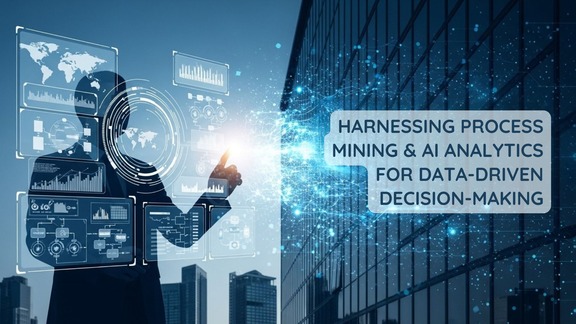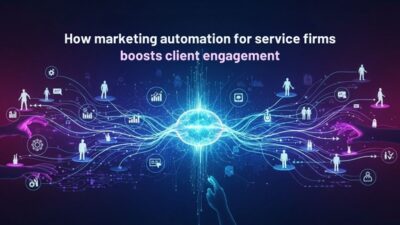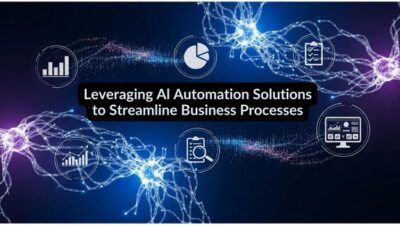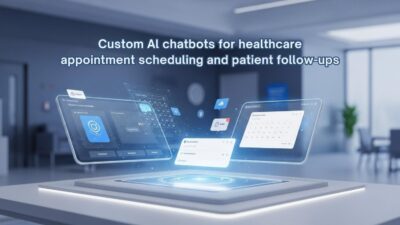Introduction
TL;DR Business leaders make critical decisions based on incomplete information daily. They rely on department reports that arrive weeks late. Process inefficiencies hide within complex operations. Nobody sees the complete picture of how work actually flows.
Your organization generates massive amounts of operational data continuously. ERP systems log every transaction. CRM platforms capture customer interactions. Workflow tools track task completion timestamps. This digital exhaust holds untapped insights about true operational reality.
Traditional process analysis methods fall short catastrophically. Manual observation captures tiny snapshots of operations. Interviews reveal what people think happens rather than actual reality. Process documentation becomes outdated within weeks of creation. The gap between perceived and actual processes costs millions.
Process mining and AI analytics unlock the truth hidden in your data. The technology reconstructs actual workflows from system logs. It reveals bottlenecks, deviations, and inefficiencies objectively. Machine learning identifies patterns invisible to human observers.
Understanding process mining and AI analytics transforms decision-making fundamentally. Leaders gain real-time visibility into operational reality. They identify improvement opportunities through data rather than guesswork. Investments target actual problems instead of perceived issues.
This comprehensive guide explores how organizations harness these technologies successfully. You’ll discover practical applications across industries and functions. Implementation strategies ensure rapid value realization. Your decisions gain solid foundations in operational truth.
Table of Contents
Understanding Process Mining and AI Analytics
Process mining extracts knowledge from event logs automatically. The technology analyzes timestamps and activities from business systems. It reconstructs the actual sequence of steps in processes. Visual process maps emerge from raw data without manual documentation.
AI analytics applies machine learning to identify patterns and anomalies. Algorithms detect deviations from standard workflows automatically. They predict where processes will bottleneck before it happens. Optimization recommendations emerge from millions of analyzed process executions.
Event logs form the foundation of process mining. Every system action creates a timestamp and activity record. These digital breadcrumbs show precisely what happened when. The accumulation of logs reveals complete process reality.
Process discovery algorithms automatically generate process models. They identify all process variants occurring in reality. Common paths and rare exceptions both become visible. Documentation updates itself continuously from live data.
Conformance checking compares actual processes against intended designs. The system highlights where reality deviates from standards. It quantifies compliance rates objectively. Problem areas surface for corrective action.
Performance analysis measures efficiency across process dimensions. Cycle times, waiting periods, and resource utilization all get quantified. Benchmarking reveals best and worst performers. Improvement targets gain data-driven foundations.
Predictive capabilities forecast process outcomes and issues. Machine learning models predict completion times and potential failures. Early warnings enable proactive interventions. Resource allocation optimizes based on anticipated demand.
The Business Value of Process Mining
Hidden inefficiencies surface through objective analysis. Processes everyone assumed worked well reveal shocking waste. Bottlenecks appear that nobody recognized existed. Quantified opportunities justify improvement investments.
Cost reduction happens through targeted optimization. You eliminate waiting time and unnecessary handoffs. Resource allocation aligns with actual workload patterns. Efficiency gains translate directly to bottom-line savings.
Cycle time reductions improve customer satisfaction measurably. Orders process faster through streamlined workflows. Customer inquiries resolve in fewer steps. Experience improvements drive loyalty and retention.
Compliance verification becomes systematic rather than sporadic. Audit trails exist for every process execution. Deviations from required procedures get flagged automatically. Regulatory risk decreases through comprehensive monitoring.
Quality improvements emerge from root cause understanding. The system identifies which process variations produce defects. Standardization happens based on best-performing workflows. Error rates decline through data-driven refinement.
Digital transformation initiatives gain clear direction. Technology investments target actual friction points. Implementation priorities rank by potential impact. ROI calculations rest on solid operational data.
Continuous improvement programs accelerate dramatically. Process mining and AI analytics provide constant feedback. A/B testing of process changes shows results immediately. Iterative enhancement becomes systematic rather than sporadic.
Key Components of Process Mining Technology
Data extraction connects to existing business systems. The technology reads event logs from ERP, CRM, and workflow platforms. It handles multiple data formats and structures. No system modifications or disruptions occur during implementation.
Process discovery algorithms automatically generate visual models. They map every activity, decision point, and pathway. Frequency indicators show common versus rare routes. Complexity becomes visible and understandable.
Conformance checking validates adherence to standards. The system compares discovered processes against reference models. It calculates compliance percentages automatically. Deviations get categorized by severity and frequency.
Performance dashboards visualize key process metrics. Cycle time distributions show variability clearly. Bottleneck analysis identifies slowest process stages. Resource utilization reveals capacity constraints.
Variant analysis reveals process diversity. The system groups similar execution paths together. It quantifies how many different ways processes actually run. Standardization opportunities become evident.
Root cause analysis identifies factors influencing outcomes. The technology correlates process characteristics with results. It reveals which conditions lead to delays or defects. Cause-and-effect relationships emerge from data patterns.
Simulation capabilities test improvement scenarios. You model process changes before implementing them. The system predicts impact on performance metrics. Risk-free experimentation guides decision-making.
AI Analytics Enhancements to Process Mining
Machine learning predicts process outcomes accurately. Models train on historical execution data. They forecast completion times and success probabilities. Predictions improve continuously as more data accumulates.
Anomaly detection identifies unusual process behaviors automatically. The system learns normal patterns from data. It flags deviations requiring investigation. Early warnings prevent small issues from escalating.
Natural language processing analyzes unstructured process data. Email content and case notes contain valuable insights. The technology extracts themes and sentiment automatically. Textual information enriches quantitative analysis.
Clustering algorithms group similar process instances. They identify customer segments with distinct process needs. Resource allocation optimizes for different process types. Personalization becomes possible at scale.
Prescriptive analytics recommends specific actions. The system suggests which process changes will yield best results. It prioritizes improvement initiatives by expected impact. Decision-making gains intelligent guidance.
Reinforcement learning optimizes processes continuously. AI agents learn which actions produce best outcomes. They adjust routing and resource allocation dynamically. Performance improves without human intervention.
Deep learning handles complex pattern recognition. Neural networks identify subtle process relationships. They predict outcomes from multitude of variables. Accuracy exceeds traditional analytical methods.
Implementing Process Mining in Your Organization
Assessment identifies highest-value process candidates. Evaluate processes by business impact and pain level. Consider data availability and quality carefully. Prioritize processes with clear improvement potential.
Data preparation ensures successful analysis. Extract relevant event logs from source systems. Validate data completeness and accuracy. Clean and transform data into required formats.
Tool selection requires evaluating multiple platforms. Compare vendors based on your specific requirements. Verify integration capabilities with existing systems. Request demonstrations using your actual data.
Pilot programs validate approach before scaling. Select one process for initial implementation. Achieve quick wins that demonstrate value. Build organizational confidence through early success.
Stakeholder engagement ensures adoption and impact. Involve process owners from project beginning. Share insights transparently across organization. Address concerns about transparency proactively.
Technical integration connects mining tools to data sources. Establish automated data pipelines for continuous analysis. Ensure security and access controls meet requirements. Plan for scalable infrastructure from start.
Training prepares teams to interpret insights. Process owners need to understand visualizations. Analysts require deeper technical knowledge. Executives learn to base decisions on mining findings.
Governance frameworks guide appropriate usage. Establish data privacy and security protocols. Define who can access which process information. Create guidelines for acting on discovered insights.
Process Mining and AI Analytics Across Industries
Manufacturing operations optimize production workflows. The technology identifies equipment downtime patterns. It reveals quality control bottlenecks clearly. Production scheduling improves through data-driven insights.
Healthcare organizations streamline patient journeys. Process mining shows actual care delivery pathways. It identifies delays in diagnosis and treatment. Patient outcomes improve through process optimization.
Financial services enhance transaction processing. Loan origination workflows get optimized systematically. Fraud detection improves through pattern recognition. Regulatory compliance monitoring becomes comprehensive.
Retail businesses improve order fulfillment processes. Inventory management optimizes based on demand patterns. Customer service workflows become more efficient. Omnichannel experiences improve through unified analysis.
Telecommunications providers reduce service activation times. Trouble ticket resolution accelerates through process insights. Network maintenance scheduling optimizes resource deployment. Customer churn decreases with faster issue resolution.
Supply chain operations gain unprecedented visibility. Procurement processes optimize across global networks. Logistics routing improves through pattern analysis. Inventory levels adjust based on actual flow patterns.
Professional services firms optimize project delivery. Resource allocation matches actual workload patterns. Project workflows standardize around best practices. Client satisfaction improves through predictable delivery.
Measuring Impact and ROI
Cycle time reductions quantify efficiency gains. Compare process durations before and after improvements. Track reductions across different process variants. Efficiency improvements translate to cost savings.
Cost savings calculations show financial impact. Measure reduced labor hours and overtime. Quantify eliminated waste and rework. Calculate decreased error correction costs.
Compliance improvements reduce regulatory risk. Track conformance rate increases over time. Measure decreased audit findings and violations. Quantify avoided penalties and legal costs.
Quality metrics demonstrate output improvements. Monitor defect rates and customer complaints. Track first-time-right percentages. Measure warranty claims and returns.
Customer satisfaction scores reflect experience improvements. Survey customers about process interactions. Monitor Net Promoter Score changes. Track customer effort scores systematically.
Employee satisfaction improves with better processes. Survey staff about workflow frustrations. Measure turnover rates among process workers. Track internal complaints about operational issues.
Return on investment calculations justify continued use. Compare technology costs against quantified benefits. Most organizations achieve positive ROI within 12 to 18 months. Benefits compound over years of usage.
Overcoming Implementation Challenges
Data quality issues undermine analysis accuracy. Incomplete event logs produce unreliable insights. Inconsistent timestamps create false patterns. Invest in data governance before mining implementation.
System integration complexity slows deployment. Legacy systems lack modern connectivity options. Custom extraction scripts require development effort. Plan sufficient time for integration work.
Organizational resistance threatens adoption success. Process owners fear transparency will expose problems. Staff worry about job security implications. Communicate benefits and intentions clearly from start.
Technical expertise requirements limit capability. Process mining demands specialized analytical skills. AI analytics requires data science knowledge. Invest in training or hire expertise.
Privacy concerns require addressing proactively. Employee monitoring creates legitimate worries. Customer data privacy needs protection. Establish clear policies about data usage.
Change management challenges slow improvement realization. Discovering issues doesn’t automatically fix them. Implementing changes requires organizational will. Link mining insights to action plans clearly.
Budget constraints limit tool selection options. Comprehensive platforms seem expensive initially. Proof-of-concept projects build investment justification. Calculate opportunity costs of delayed implementation.
Advanced Process Mining Capabilities
Real-time process monitoring provides live visibility. Dashboards update continuously from streaming data. Alerts notify stakeholders of emerging issues. Intervention happens before problems compound.
Multi-system process mining spans organizational boundaries. The technology follows processes across different platforms. End-to-end visibility emerges despite system fragmentation. Holistic optimization becomes possible.
Process comparison benchmarks performance objectively. The system compares different departments or locations. Best practices surface from top performers. Knowledge transfer becomes data-driven.
What-if simulation tests improvement scenarios. You model process changes before implementing. The system predicts impact on key metrics. Risk-free experimentation guides investments.
Automated process improvement suggests optimizations. AI recommends specific changes based on patterns. It prioritizes suggestions by expected impact. Continuous improvement becomes algorithmic.
Integration with RPA identifies automation opportunities. Process mining reveals repetitive manual tasks. Robotic process automation handles identified opportunities. Human work shifts toward judgment and creativity.
Social network analysis reveals collaboration patterns. The technology maps interactions between process participants. It identifies communication bottlenecks and silos. Organizational design improves through insights.
Best Practices for Maximum Value
Start with high-impact processes showing clear pain. Early wins build momentum for broader adoption. Success stories convince skeptical stakeholders. Momentum accelerates from visible results.
Involve process owners from project beginning. Their knowledge guides effective analysis. Their buy-in ensures implementation of improvements. Collaboration produces better outcomes than mandates.
Focus on actionable insights rather than data volume. Pretty visualizations without action waste resources. Link every insight to potential improvement. Create accountability for implementing changes.
Establish continuous monitoring rather than one-time analysis. Processes evolve constantly over time. Ongoing monitoring catches emerging issues early. Process mining becomes operational rather than project-based.
Combine quantitative mining with qualitative understanding. Data shows what happens but not always why. Talk to process participants about discovered patterns. Full understanding requires both perspectives.
Share insights transparently across organization. Break down information silos through visibility. Create common understanding of operational reality. Collective intelligence improves through shared knowledge.
Measure everything before and after changes. Establish baseline metrics during initial analysis. Track improvements from implemented changes. Data-driven accountability drives continuous progress.
Celebrate and communicate success stories. Recognition motivates further improvement efforts. Visibility attracts resources for expansion. Positive momentum becomes self-reinforcing.
Future Trends in Process Intelligence
Predictive process mining will forecast issues weeks ahead. Advanced AI will predict where processes will break. Proactive intervention will prevent problems entirely. Operations will become truly predictive rather than reactive.
Autonomous process optimization will adjust workflows automatically. AI agents will identify and implement improvements. Human approval will focus on strategic changes only. Self-healing processes will emerge.
Process mining and AI analytics will extend to customer journeys. Cross-company process visibility will emerge. Supply chain partners will share process insights. Ecosystem-wide optimization will become possible.
Quantum computing will enable real-time analysis of massive processes. Complex simulations will complete instantaneously. Pattern recognition will reach new sophistication levels. Computational limits will disappear.
Blockchain will create immutable process audit trails. Process verification will become tamper-proof. Trust will increase through transparent recording. Compliance verification will strengthen dramatically.
Edge computing will enable process analysis at data sources. Manufacturing floors will process data locally. Cloud connectivity requirements will decrease. Real-time responsiveness will improve substantially.
Frequently Asked Questions
What are process mining and AI analytics exactly?
Process mining extracts knowledge from event logs in business systems. The technology reconstructs actual workflows from timestamp data. It reveals how processes really run versus how we think they run. AI analytics applies machine learning to identify patterns and predict outcomes. Algorithms detect anomalies and recommend optimizations. The combination provides unprecedented process visibility and intelligence. Organizations gain objective understanding of operational reality.
How does process mining differ from traditional process analysis?
Traditional analysis relies on interviews and observation. It captures small samples during brief periods. Documentation becomes outdated quickly. Process mining analyzes every process execution automatically. It reveals complete reality across all variants. Updates happen continuously from live data. The difference is comprehensive objectivity versus limited subjectivity. Scale and accuracy improve dramatically with mining.
What data does process mining require?
Event logs from business systems provide necessary data. Each log entry needs case ID, activity name, and timestamp. Additional attributes like resource and cost enrich analysis. Most ERP, CRM, and workflow systems generate suitable logs. Data extraction happens without system modifications. Historical data going back months or years works fine. More data generally produces better insights.
How long does implementation take?
Proof-of-concept projects complete in four to six weeks. Basic process mining shows initial insights quickly. Comprehensive implementations require three to six months. Data preparation often takes longer than expected. Integration complexity varies by system landscape. Most organizations see actionable insights within 60 days. Full maturity develops over six to twelve months.
What results can organizations expect?
Cycle time reductions of 20% to 50% are common. Cost savings reach 15% to 30% of process costs. Compliance rates improve by 10 to 25 percentage points. Customer satisfaction scores increase measurably. Specific results depend on starting point and improvement effort. Most organizations achieve ROI within 12 to 18 months. Benefits compound over years of usage.
Do we need data scientists to use process mining?
Modern platforms make basic analysis accessible to business users. Advanced analytics require some technical expertise. Many organizations hire consultants for initial implementation. Internal capability builds through training and practice. Data science skills enhance but aren’t mandatory. Process knowledge matters more than technical prowess initially. Technical depth becomes valuable for advanced applications.
How does process mining handle process variations?
The technology identifies all process variants automatically. It groups similar execution paths together. Frequency indicators show common versus rare variants. You analyze why variations occur and whether they’re problematic. Standardization happens based on data about outcomes. Necessary flexibility gets distinguished from wasteful deviation. Management by exception becomes data-driven.
Can process mining and AI analytics work with our systems?
Most modern business systems generate compatible event logs. ERP, CRM, and workflow platforms all work well. Legacy systems may require custom extraction scripts. Cloud and on-premise systems both support mining. Integration capabilities vary by mining platform vendor. Conduct data availability assessment before selecting tools. Most system landscapes support process mining with some preparation.
Read More:-Modernising Legacy Systems with Process Mining and AI Analytics
Conclusion

Process mining and AI analytics revolutionize how organizations understand operations. The technologies reveal objective truth about how work actually flows. Hidden inefficiencies surface through comprehensive analysis. Decision-making gains solid foundations in operational data.
Traditional process analysis methods provide incomplete pictures. Manual observation captures tiny snapshots only. Documentation becomes outdated before publication. The gap between perception and reality costs millions.
Implementation requires thoughtful planning and execution. Data preparation ensures analysis accuracy. Tool selection determines long-term capabilities. Stakeholder engagement drives adoption and impact.
Results materialize across multiple dimensions simultaneously. Cycle times decrease through targeted optimization. Costs fall as waste gets eliminated. Compliance improves through systematic monitoring.
Measuring success proves value quantitatively. Efficiency metrics show clear improvements. Financial analysis calculates concrete ROI. Most organizations achieve positive returns within 18 months.
Starting with high-impact processes makes sense. Early wins build momentum for expansion. Success stories convince skeptical stakeholders. Organizational capability grows through practice.
The competitive landscape demands operational excellence. Organizations using process intelligence outperform those relying on intuition. Data-driven decisions beat experience-based guesses. Technology provides advantages manual analysis cannot match.
Your operations generate valuable data continuously. Event logs contain insights about improvement opportunities. This digital exhaust holds answers to operational challenges. The question becomes whether you’ll extract that value.
Future developments will enhance capabilities further. Predictive analytics will forecast issues earlier. Autonomous optimization will implement improvements automatically. Early adopters will maintain competitive advantages.
Take the first step toward process intelligence today. Assess data availability across your systems. Identify processes causing most pain currently. Research platforms serving your industry specifically.
Implementation timelines mean decisions today affect performance months ahead. Waiting costs money through continued inefficiency. Competitors gain advantages while you delay. The gap between leaders and followers widens continuously.
Your organization deserves objective operational understanding. Decision-makers need accurate process visibility. Improvement initiatives require data-driven targeting. Process mining and AI analytics deliver all outcomes simultaneously.
Start evaluating platforms and building your business case now. Request vendor demonstrations with your actual data. Calculate potential ROI using realistic assumptions. Talk to organizations in your industry who implemented successfully.
The technology exists today to transform decision-making. Process mining reveals operational truth objectively. AI analytics provides intelligent recommendations. Your success depends on adoption speed and implementation quality.
Begin your process intelligence journey immediately. Your operations hold untapped improvement potential. Data contains answers to longstanding challenges. The only question is when you’ll unlock those insights.





